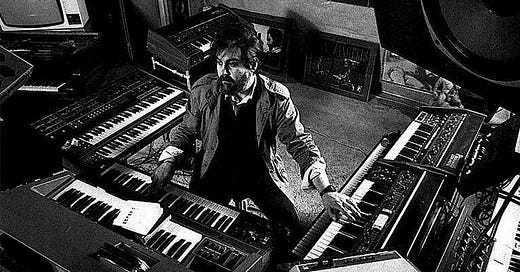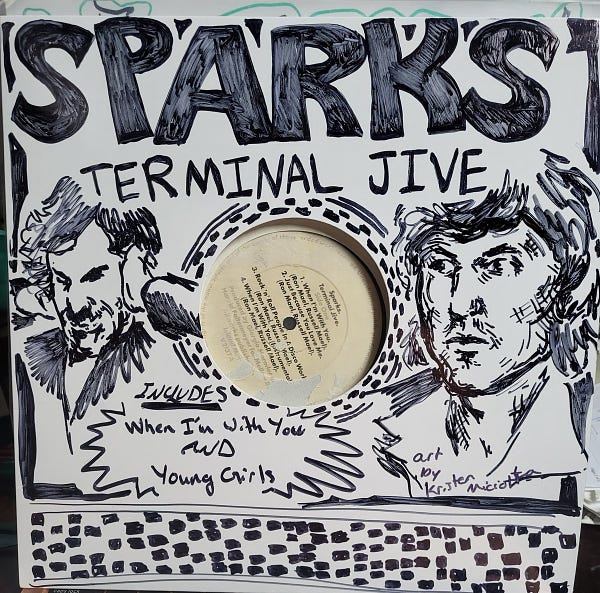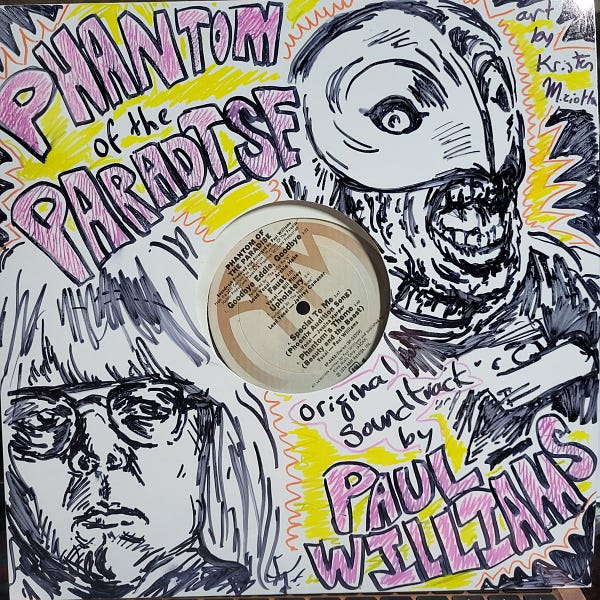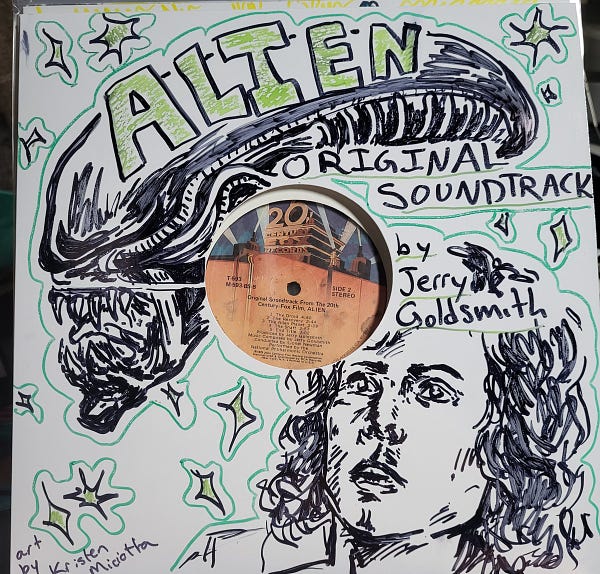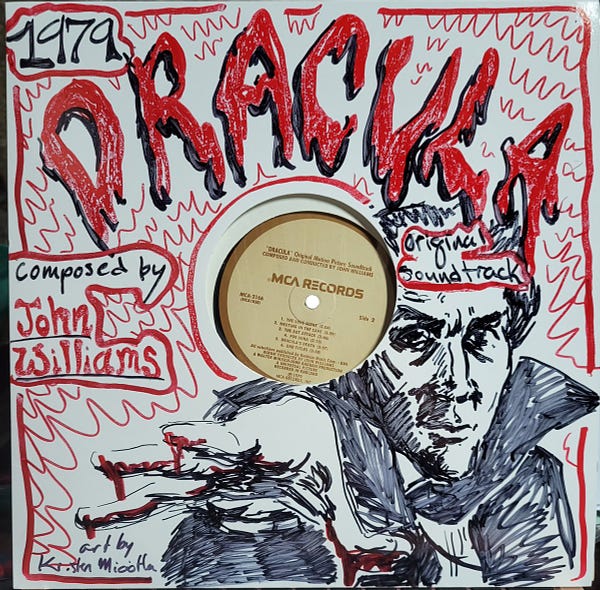I read with sadness about the death of Greek composer, performer, and producer Vangelis. He touched on so many musical genres and was able to invoke real emotion with his work utilizing electronic instruments and studio techniques. A true pioneer in electronic music he was able to meld the modern ideas of artists like Jean Michel Jarre and Edgar Froese with neo-Classical orchestration and a healthy dose of Romanticism for good measure. Vangelis certainly deserves to be remembered in the company of Jarre, Froese, and Wendy Carlos.
.
Vangelis first appeared in a band called Aphrodite's Child, a Greek group who surfaced at the end of the 1960s with a British-influenced psychedelic feel. In 1970 the group unleashed its magnum opus, 666, a prog rock double album based on the biblical Book of Revelations, but the group had disbanded by the time of its release. Nonetheless, 666 is an iconic prog album, even if it is difficult at times not to imagine that Aphrodite's Child may have provided inspiration for some of Spinal Tap's psychedelic/prog antics.
Vangelis continued with the biblical inspiration with his 1975 release Heaven and Hell. The album was the first Vangelis recorded at Nemo Studios, the studio he built and owned in London, where he had moved. He continued to record his work there, including his soundtracks for Chariots of Fire and Blade Runner, until 1987. Heaven and Hell was notable for another reason--it brought Vangelis into the orbit of Jon Anderson of Yes. The band had auditioned Vangelis as a replacement for Rick Wakeman, but either they didn't think there was a fit or he didn't want to play music that had already been more or less composed by the rest of the band. Whichever, it didn't happen, but Anderson did sing on the final track on side one of Heaven and Hell. The track, "So Long, So Clear" is one of transcendent magic and beauty, reminiscent of "Soon," a song Anderson wrote around the same time and which appeared on the Yes album Relayer, the first without Wakeman.
Vangelis' warm orchestral synthesizers are much more sympathetic ot Anderson's vocals than the more brittle work of Yes keyboard player Patrick Moraz. Of course one wonders what might have been had the Greek keyboardist joined Yes, or if Anderson re-recorded Tales From Topographic Oceans with more sympathetic musicians.
Anderson and Vangelis reunited in 1979, when Anderson left Yes, and proceeded to record four albums as Jon & Vangelis between 1980 and 1991. Anderson had recorded his first solo record, Olias of Sunhillow, and his work there as well as on the Yes albums Tormato and Going For The One signaled a different style of writing for him, one that is presaged by some of the passages on Short Stories, the first Jon & Vangelis record. Anderson's vestiges of often hymnal melody are given free range to ascend, with appropriate support and orchestral strength from Vangelis when needed. With fewer egos to feed (no guitarist, no drummer, no Wakeman) Vangelis provides a very sympathetic musical setting for Anderson's lyrics and vocal work.
I suggest that, while one's enjoyment of some of the duo's work depends on whether one adores or simply tolerates Anderson's voice and lyrics, they are a significant body of prog/electronic work and they form a significant part of Vangelis' discography. It's rather incredible that he was able to compose and perform the musical tracks for such a variety of styles. On "The Friends of Mr. Cairo" he manages to evoke the electro-pop of Kraftwerk and the mysterious atmospherics of Gary Numan and Ultravox circa Vienna. On "The Mayflower" he updates the classic Yes sound.
'Cinematic' is a term that has been applied to Vangelis' work, and it seems perfectly logical that, given his neo classical bent and his love of atmospheric programmatic music he should be a celebrated soundtrack composer and contributor. His work for the 1981 film Chariots of Fire is by far his most familiar work to the public at large, but to fans of dystopian alt sci-fi and futuristic electronica he is closely connected with Ridley Scott's Bladerunner. What is perhaps more interesting than the soundtracks themselves is the fact that Vangelis managed to fit synthesizer music into each film without undercutting its visuals or atmosphere in any way. The score for Chariots of Fire is elegant and heroic, registering more as a symphonic score, with no dissonance occurring with the film's 1920s setting. Bladerunner is, of course, futuristic and mechanized, with sounds and dialogue from the film dropped into the mix, yet there is still a recognizable human element to the music that adds dimension to the images on the screen and supports the tension of human vs. machine of the story.
Vangelis' career was defined during certain phases by his collaborations with other artists or his soundtrack work, but he maintained a prolific solo recording career up until his death. While his work is at times reminiscent of the work of pioneering electronic artists Tangerine Dream and Jean Michel Jarre, it is defined to a certain extent by his robust talent as a keyboard player. Not every synthesist is a gifted keyboard player since it is possible to rely on sequencing to handle more difficult passages. On the other hand, not every talented keyboardist in prog has the imagination and skill to utilize synthesizers as a complete sound palette, with Rick Wakeman and Keith Emerson springing to mind.
Vangelis plays his synths like he is onstage, moving his fingers across the keys. I am reminded of Terry Riley, who was a talented keyboard player and whose pioneering use of electronic figures was to provide a background for his live keyboard improvisations. That element of improvisation is missing from many of the European electronic heavyweights of the period, but for Vangelis it was part of his work habit: many of his works were recorded based on what he laid down on his first take. His early solo records, in particular, are constant reminders that Vangelis was a real time musician as well as an electronics whiz and composer.
Albedo 3.9, the record that followed Heaven & Hell, finds him jamming in a fusion environment, sounding a lot like Joe Zawinul or Chick Corea on the track "Main Sequence." The followup record, Spiral, has a title track where Vangelis uses sequenced figures and overdubs to create a sense of infinity, each moment creating a chain that spirals into the ether like the headphone cord pictured on the album's cover.
All of this merely touches on some of the work that I personally find most rewarding in Vangelis' large discography. There is a great deal of music there that will inspire and provide enjoyment for listeners with the time and inclination to investigate it.
Lagniappe
From Chicago’s own Laurie’s Planet of Sound touting the work of employee Kristen Miciotta, who draws cover art by hand for records that arrive in good condition without the original sleeve. You can check out her other art work at IG, some of which is for sale, as well.

